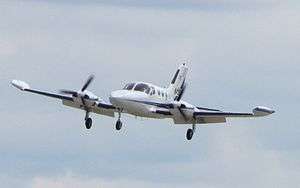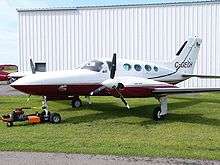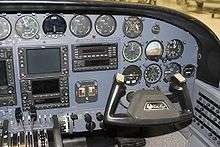Cessna 421
| Cessna 421 Golden Eagle | |
|---|---|
 | |
| Cessna 421B landing | |
| Role | Light transport |
| National origin | United States |
| Manufacturer | Cessna |
| First flight | October 14, 1965 |
| Produced | 1967–1985 |
| Number built | 1916 |
| Developed from | Cessna 411 |
The Cessna 421 Golden Eagle is an American six or seven seat twin-engined light transport aircraft, developed in the 1960s by Cessna as a pressurised version of the earlier Cessna 411.[1]
Development
The Cessna 421 was first produced in May 1967. The 421A appeared in 1968 and the aircraft was redesigned in 1970 and marketed as the 421B. In 1975 the 421C appeared which featured wet wings, the absence of wingtip fuel tanks and landing gear that was changed from straight-leg to a trailing-link design from the 1981 model year onwards. Production ended in 1985 after 1,901 aircraft had been delivered.
The 421 was first certified on 1 May 1967 and shares a common type certificate with models 401, 402 411, 414 and 425.[2]
Some 421s have been modified to accept turboprop engines,[3] making them very similar to the Cessna 425, which itself is a turboprop development of the 421.[4]
Design
The 421 is an all-metal low-wing cabin monoplane with a retractable tricycle landing gear, and powered by two geared[lower-alpha 1] Continental GTSIO-520-D engines, wing-mounted in tractor configuration. The cabin is accessed from a door, on the left hand side behind the wing, and has seating for six on the basic 421, or up to ten on later variants.
Variants



- 421
- Type approved 1 May 1967, powered by two Continental GTSIO-520-Ds of 375 hp (280 kW) each, maximum takeoff weight 6,800 lb (3,084 kg).[2] 200-built.[1]
- 421A
- Type approved 19 November 1968, powered by two Continental GTSIO-520-Ds of 375 hp (280 kW) each, maximum takeoff weight 6,840 lb (3,103 kg).[2] 158-built.[1]
- 421B Golden Eagle/Executive Commuter
- Eight-seat light passenger transport aircraft. Type approved 28 April 1970, powered by two Continental GTSIO-520-Hs of 375 hp (280 kW) each, maximum takeoff weight 7,250 lb (3,289 kg), later models 7,450 lb (3,379 kg).[2] 699-built.[1]
- 421C Golden Eagle/Executive Commuter
- Model with new wing and landing gear. Type approved 28 October 1975, powered by two Continental GTSIO-520-Ls or Continental GTSIO-520-Ns of 375 hp (280 kW) each, maximum takeoff weight 7,450 lb (3,379 kg).[2] 859-built.[1]
- Riley Turbine Rocket 421
- Conversion of Cessna 421 aircraft by fitting two Lycoming LTP101 turboprop engines. Formal designation R421BL and R421CL for conversions of 421B and C respectively.[3]
- Riley Turbine Eagle 421
- Conversion of Cessna 421C aircraft by fitting two 750hp Pratt & Whitney Canada PT6A-135 turboprop engines. Formal designation R421CP.[3]
- Excalibur 421
- Re-engined 421C with Pratt & Whitney Canada PT6A-135A or PT6A-112 turboprops, supplemental type certificate held by Excalibur 421 LLC of Paso Robles, California.[5] In 2013 it was announced that Aviation Alliance are acting as program managers for the Excalibur 421 updagrade programme.[6]
- Advanced Aircraft Regent 1500
- Production of the Riley Turbine Eagle 421 conversion by Advanced Aircraft Corporation.[7]
Military operators
- Bolivian Air Force at least one 421B was in use.[8]
- Royal New Zealand Air Force three 421C.[11]
- Pakistan Army Aviation at least one 421 in use.[12]
- Turkish Army Aviation at least three 421Bs in use.[13]
- Air Force of Zimbabwe at least one 421A in use.[14]
Specifications (C 421C)



Data from Jane's All The World's Aircraft 1976–77 [15]
General characteristics
- Crew: One or two
- Capacity: Six passengers
- Length: 36 ft 9⅝ in (11.09 m)
- Wingspan: 41 ft 1½ in (12.53 m)
- Height: 11 ft 5⅜ in (3.49 m)
- Wing area: 215 ft² (19.97 m²)
- Empty weight: 4,501 lb (2,041 kg)
- Max. takeoff weight: 7,450 lb (3,379 kg)
- Powerplant: 2 × Continental GTSIO-520-L turbocharged, fuel injected and geared six-cylinder horizontally-opposed air-cooled piston engine, 375 hp (280 kW) each
- Pressurised 6-8 seat cabin twin.
Performance
- Maximum speed: 256 knots (475 km/h, 295 mph) at 20,000 ft (6,100 m)
- Cruise speed: 240 knots (444 km/h, 276 mph) at 25,000 ft (7,600 m) (75% power)
- Range: 1,487 nmi (2,755 km, 1,712 miles)
- Service ceiling: 30,200 ft (9,205 m)
- Rate of climb: 1,940 ft/min (9.9 m/s)
See also
- Related development
- Aircraft of comparable role, configuration and era
Notes
- ↑ The gearing means that rather than the driveshaft being directly connected to the propeller, it drives through a set of reduction gears.
References
- 1 2 3 4 5 Simpson, R.W. (1995). Airlife's general aviation : a guide to postwar general aviation manufacturers and their aircraft (2nd ed.). Shrewsbury: Airlife. ISBN 978-1853105777.
- 1 2 3 4 5 Federal Aviation Administration (March 2007). "TYPE CERTIFICATE DATA SHEET NO. A7CE Revision 47". Retrieved 2009-11-05.
- 1 2 3 Taylor 1982, p. 455.
- ↑ Taylor 1982, p. 352.
- ↑ "FAA Supplemental Type Certificate SA1361SO" (pdf). rgl.faa.gov. FAA. Retrieved 28 February 2015.
- ↑ "The Aviation Alliance Announces First Product Offering, Excalibur 421". www.prnewswire.com. Retrieved 28 February 2015.
- ↑ Taylor 1988, p. 321.
- ↑ Andrade 1982, p. 27
- ↑ Penney, Stuart (27 November – 3 December 2001). "World Air Forces 2001: Cambodia". Flight International. Vol. 160 no. 4808. p. 39.
- ↑ Andrade 1982, p. 126
- ↑ Andrade 1982, p. 165
- ↑ Andrade 1982, p. 174
- ↑ Andrade 1982, p. 229
- ↑ Andrade 1982, p. 346
- ↑ Taylor 1976, pp. 272–273.
- Bibliography
- Simpson, R.W. (1995). Airlife's general aviation : a guide to postwar general aviation manufacturers and their aircraft (2nd ed.). Shrewsbury: Airlife. ISBN 978-1853105777.
- John W.R. Taylor, ed. (1976). Jane's All the World's Aircraft 1976-77. London: Jane's yearbooks. ISBN 0-354-00538-3.
- Taylor, John W.R. (1982). Jane's All the World's Aircraft 1982-83. London: Jane's Publishing Company. ISBN 978-0-7106-0748-5.
- Taylor, John W.R. (1983). Jane's All the World's Aircraft 1988-89. Coulsdon, UK: Jane's Defence Data. ISBN 0-7106-0867-5.
External links
![]() Media related to Cessna 421 at Wikimedia Commons
Media related to Cessna 421 at Wikimedia Commons